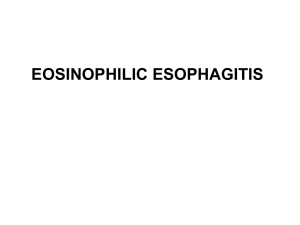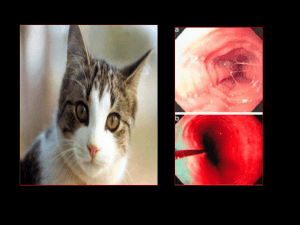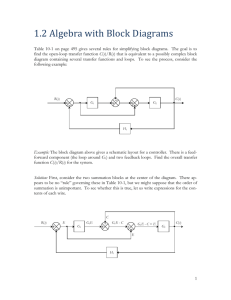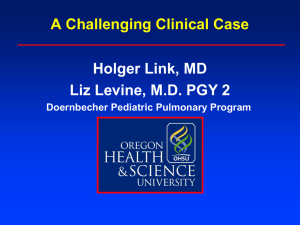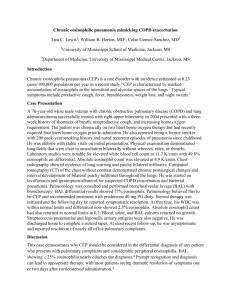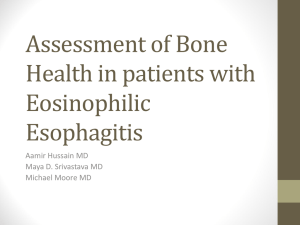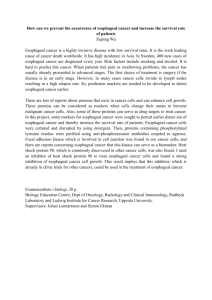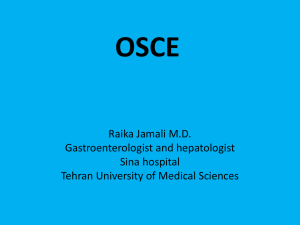Esophageal pH-monitoring - HAL
advertisement
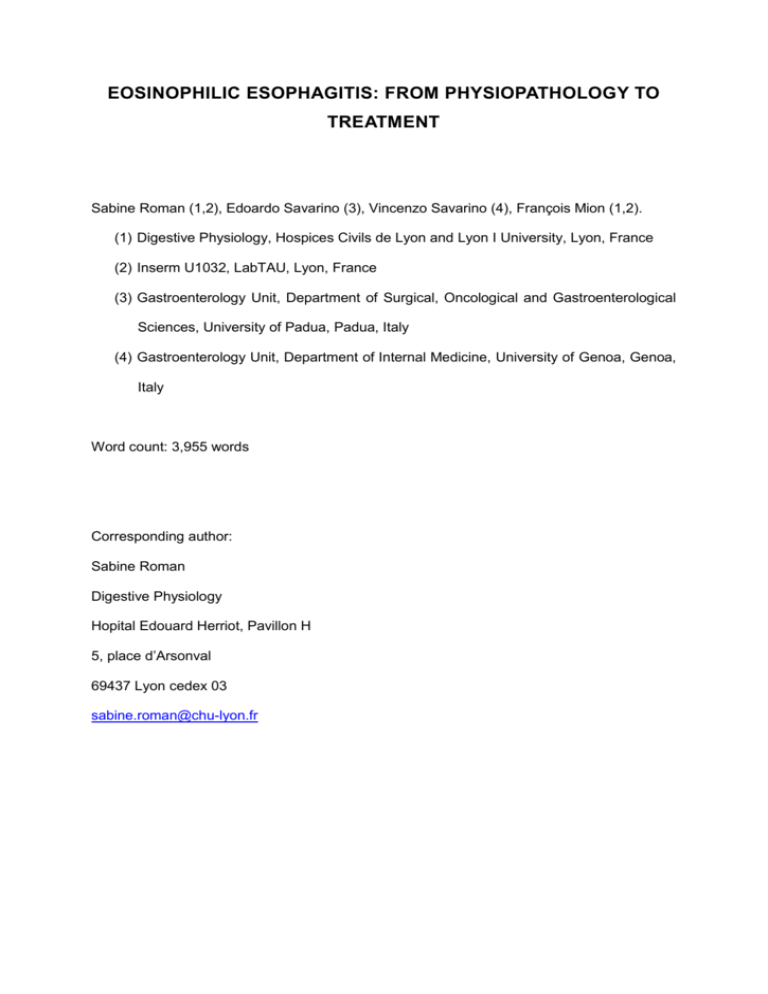
EOSINOPHILIC ESOPHAGITIS: FROM PHYSIOPATHOLOGY TO TREATMENT Sabine Roman (1,2), Edoardo Savarino (3), Vincenzo Savarino (4), François Mion (1,2). (1) Digestive Physiology, Hospices Civils de Lyon and Lyon I University, Lyon, France (2) Inserm U1032, LabTAU, Lyon, France (3) Gastroenterology Unit, Department of Surgical, Oncological and Gastroenterological Sciences, University of Padua, Padua, Italy (4) Gastroenterology Unit, Department of Internal Medicine, University of Genoa, Genoa, Italy Word count: 3,955 words Corresponding author: Sabine Roman Digestive Physiology Hopital Edouard Herriot, Pavillon H 5, place d’Arsonval 69437 Lyon cedex 03 sabine.roman@chu-lyon.fr Page 2 of 26 Abstract Eosinophilic esophagitis is a chronic inflammatory disease characterized by eosinophilic infiltration of the esophageal mucosa. Food and aero-allergens are involved in its pathogenesis. Dysphagia and food impaction are the dominant symptoms in adult with eosinophilic esophagitis. However, a wide range of symptoms has been noticed such as chest pain or gastro-esophageal reflux disease-like symptoms. Upper gastro-intestinal endoscopy and esophageal biopsies are crucial for the diagnosis of eosinophilic esophagitis. Endoscopy might be normal or reveals typical patterns such as rings, furrows, exudates, edema, and stricture. Two to four biopsies should be performed both in the distal and in the proximal esophagus. Fifteen eosinophils per high power field within the esophageal epithelium are the minimal threshold to diagnose eosinophilic esophagitis. Allergy testing is recommended, although its impact to orient treatment remains to be demonstrated. Eosinophilic esophagitis treatment includes medical treatment, diet and endoscopic dilation. Proton pump inhibitors are the first-line therapy as some eosinophilic esophagitis phenotypes respond well to proton pump inhibitors. Topical viscous corticosteroids or diet elimination are the treatment of choice. There is no clear evidence in the literature to prefer one to the other. Finally endoscopic dilation should be considered in case of persistent symptomatic stenosis despite medical therapy. Word count: 200 Page 3 of 26 Introduction Eosinophilic infiltration of the esophagus was firstly described in adults with dysphagia in the 1990s [1]. It was recognized as being different from gastro-esophageal reflux disease (GERD). A recent international consensus defined eosinophilic esophagitis (EoE) as “a chronic, immune/antigene-mediated disease characterized clinically by symptoms related to esophageal dysfunction and histologically by eosinophil-predominant inflammation”. Since the first description, EoE incidence has dramatically increased [2, 3]. The prevalence is estimated around 43 to 55 per 100 000 inhabitants in Western countries. A recent study based on long-term follow-up tends to prove that there is a true increase of incidence and not only a better recognition by both gastroenterologists and pathologists [3]. Eosinophilic esophagitis seems to be more frequent in young male adult even if it may affect individuals at any age. Thus, age is a predictive factor of EoE in patients with dysphagia. In the outpatients who underwent endoscopy for dysphagia at Mayo Clinic, Rochester, an age ≤ 47 years was an independent predictive factor of EoE (odds ratio 0.94, 95% confidence interval 0.90-0.98, p = 0.01) [4]. In Olten county in Switzerland, the incidence of EoE was lower in women than men (relative risk = 0.585, 95% confidence interval 0.331-1.034, p=0.065) [3]. In this population the sex ratio female/female was 3:1. The aims of this review were to give a general update of this newly recognized entity including pathophysiology, clinical presentation, diagnostic modalities and treatment. Physiopathology Eosinophilic esophagitis is characterized by an eosinophil infiltration within the esophageal epithelium, and T-helper 2 (Th2) - type immune responses, which are typical of other atopic conditions. The inflammatory response is restricted to the esophagus and does not involve the stomach and the duodenum. Page 4 of 26 Inflammatory process of esophageal epithelium In EoE, the esophageal epithelium is infiltrated not only by eosinophils but also by Tcells, B cells and mast cells [5]. Increased numbers of denditric cells have also been observed in esophageal epithelium of patients with EoE. Increased levels of cytokines such as IL-4, IL-5, IL-9 and IL-13 have been noticed in esophageal mucosa of patients with EoE [6, 7]. These cytokines activate eosinophils, mast cells and B cells. Esophageal epithelium cells may be involved in this inflammatory process as well. They express TNF- and eotaxin-3 that are responsible for the recruitment of eosinophils in the esophagus. The crucial role of eotaxin-3 was demonstrated in a murine model as mice deficient in the eotaxin receptor were protected from experimental EoE. Finally, eosinophils also produce thymic stromal lymphoprotein (TSLP), a cytokine promoting Th2 differentiation. This inflammatory process is summarized in Figure 1. It induces an esophageal remodeling which leads to esophageal dysfunction and bolus impaction. Deposition of extracellular matrix proteins is associated with subepithelial fibrosis [8, 9]. Eosinophils may contribute to EoE pathogenesis by secreting Tumor Growth Factor (TGF) 1 and eosinophil granulations. TGF1 is a cytokine involved in epithelial growth, fibrosis and tissue remodeling and has been identified in EoE. Some eosinophil granulations (eosinophil cationic protein, eosinophil peroxidase for example) may have cytotoxic effects explaining epithelial cells death observed in EoE. Allergy The concept of food allergens as a primary trigger of EoE was introduced first in a pediatric cohort by Kelly et al [10]. Since then, it has become increasingly clear that there was an allergic predisposition in the EoE population. A link has been described between atopy and EoE [11, 12]. Allergic disorders (rhinitis, asthma, atopic dermatitis) are encountered in up to 70% of adults with EoE [12]. Page 5 of 26 In murine model, esophageal eosinophilia was inducible by allergens [13]. IL-13 and IL-5 were also found to be crucial for the disease development [14]. As a consequence these experimental data support the concept that EoE represents an allergic disease in which T cells and eosinophils play key pathogenic roles. In humans, relevant allergens have been identified for EoE. In children EoE seems clearly to be a food antigen-driven disease. In contrast aero-allergen sensitization has mainly been observed in adults [6]. Seasonal exacerbations of EoE in spring and summer are in favor of a potential role of aero-allergens. Elevated IgE serum levels have been observed in EoE. They were specific to food and/or aero-allergens. Positive skin prick test have also been noticed. Finally based on elimination diet and reintroduction test, wheat and milk were the most common allergens in a cohort of 50 adults (60% and 50% respectively) [15]. However, skin-prick testing predicted only 13% of food association in this cohort. Genetics Different studies have suggested genetic inheritability in EoE [6, 16]. Sibling recurrence risk ratio was estimated around 80 in EoE [17]. Genome-wide analysis has identified a susceptibility locus on chromosome 5q22 [18]. Thymic stromal lymphoprotein (TSLP) gene is located on this locus. A genetic variant in the TSLP receptor gene located on the pseudoautosomal region of the X-chromosome was also linked with EoE in males [19]. Finally variations in TGF- and filaggrin genes have been also observed in EoE [19] as well as exotoxin-3 gene polymorphism [20]. Relation between GERD and eosinophilia It is well-known that GERD may induce microscopic esophagitis and eosinophilic infiltration [21, 22] . This histological feature can be reversed by proton pump inhibitors (PPIs) therapy [23]. Some data suggested that PPIs might also be effective to treat esophageal eosinophilia in absence of identified acid reflux [24]. Thus, a subgroup of Page 6 of 26 patients has been recently recognized: this was named “PPI responsive esophageal eosinophilia” by the latest consensus meeting [19]. These patients exhibit a typical EoE symptom presentation. GERD has been excluded and these patients demonstrate a clinical and pathological response to PPIs. Different hypotheses have been raised to explain this phenotype [19]. Healing of a disrupted epithelial barrier may prevent further immune activation. Eosinophil longevity may decrease on PPIs or PPIs may have some antiinflammatory properties. In vitro, PPIs might inhibit eotaxin-3 expression by esophageal cells [25]. Clinical presentation Patients with EoE may present with a wide range of symptoms including dysphagia, food impaction, heartburn and chest pain. The clinical presentation may be very different according to the age of onset [19, 26, 27] (Table 1). In adults, intermittent dysphagia for solids is the most typical symptom of EoE (ranging from 25% up to 100%) with long-lasting food impaction representing the most frequent and severe presentation of dysphagia [19, 27]. In fact, it has been observed that about 35% to 50% of adults during the natural history of their disease experienced at least one episode of food impaction requiring emergent evaluation and endoscopic bolus removal [28, 29]. It is not uncommon that patients modify their chewing habits (i.e. eating food more slowly and washing down solid food with liquids), thereby making the clinical manifestations of EoE less evident and leading to delayed diagnosis [30]. A minority of patients complain also of retrosternal pain that may occur spontaneously or after ingestion of alcohol, acidic liquids or foods, particularly when food consistency is dry or rough and/or when patients eat too fast. Other symptoms such as nausea, vomiting or abdominal pain as well as diarrhea and weight loss can also occur [30-32]. In children below 2 years of age, feeding disorders (refusal to eat, chewing problems, choking after liquids or solids ingestion) and failure to thrive are dominant symptoms, while Page 7 of 26 up to the age of 12, vomiting, nausea, abdominal pain, water brash, heartburn and regurgitation (GERD -like symptoms) are the most common symptoms (ranging from 5% up to 82%) [19, 31-34]. Dysphagia, food impaction, chest pain and diarrhea were also reported and their frequency usually increases with age [30-32]. Finally, patients with EoE may also complain of additional atypical GERD symptoms such as asthma, hoarseness, cough, croup, rhino-sinusitis, others ear-nose-throat (ENT) symptoms and sleep-disordered breathing (ranging from 10% up to 25%) [35, 36]. No symptom in isolation is specific for the diagnosis of EoE. Regardless of age, if a patient develops GERD-like symptoms and does not respond to pharmacological or surgical treatment, EoE should be strongly suspected [19]. Finally EoE might be revealed by esophageal complications such as spontaneous perforation [19] . Perforation might be transmural (Boerhaave’s syndrome) [37] or partial as intramural tears or deep lacerations on endoscopy. These complications are rare and have been described only as clinical cases in the literature. Patients with spontaneous esophageal perforation should be assessed for EoE. Diagnosis Upper endoscopy and histopathology Upper endoscopy with esophageal biopsies is the first diagnostic step in the work up of patients with suspected EoE as well as in patients with dysphagia. Endoscopic features A considerable number of endoscopic findings might be observed in EoE (Figure 2). They include normal endoscopy, signs of active inflammation such as mucosal edema (pallor due to decreased vascular markings), exudates (whitish plaques), furrows or signs of chronic inflammation with tissue remodeling such as rings, stricture or crêpe-paper mucosa (mucosal fragility) [4, 38]. These different patterns may co-exist in the same patient. Page 8 of 26 In a cohort of 261 patients who underwent upper esophageal endoscopy for dysphagia, classic endoscopic findings (rings and/or furrows) were absent in 13 of 31 patients (42%) with EoE [38]. Five patients (16%) had completely normal endoscopy and 6 had one single stricture or Schatzki ring, one had erosive esophagitis and one presented diffuse esophageal congestion. Conversely, rings and/or furrows were identified in 14 patients whose biopsies did not meet the criteria for EoE. In another cohort, 10% of patients with normal endoscopy had EoE on biopsies while only 38% of patients with endoscopic features suggestive of EoE had eosinophilic infiltration on biopsies [4]. Thus, endoscopic features are neither sensitive nor specific of EoE. Biopsies sampling might explain some missed diagnosis of EoE. Moreover, the threshold to diagnose EoE was 20 eosinophils per high power field (hpf) in both studies, whereas this threshold is now 15 according to the consensus meeting [19]. Recently, Hirano et al proposed a standardized classification which incorporated the grading of 4 major esophageal features (rings, furrows, exudates, edema) and the presence of additional features of narrow-caliber esophagus, feline esophagus (or transient esophageal rings), stricture and crêpe paper esophagus [39]. This score was named EREFS for Endoscopic Reference Score for EoE but also for Exudates, Rings, Edema, Furrows, Stricture. Inter-observer agreement was good for the 4 major features of EoE (kappa=0.400.54) and for stricture and crêpe paper esophagus (kappa=0.52 and 0.58 respectively). It was fair for narrow-caliber esophagus (kappa=0.30) and poor for feline esophagus (kappa=0.15). It remains to be determined if this score might be used to evaluate EoE patients before and after treatment. Histology Eosinophils are not normally found in the esophageal epithelium and the quantity of intraepithelial eosinophils is a crucial component in the diagnosis of EoE. According to the latest consensus recommendations, 15 eosinophils/hpf is considered as the minimal threshold for a diagnosis of EoE in both children and adults [19]. The disease is limited to the esophagus and other causes of esophageal eosinophilia should be excluded. The main Page 9 of 26 causes encompass eosinophilic gastro-enteritis, Crohn disease, and achalasia [40]. As a consequence, it is reasonable to perform biopsies in gastric antrum and duodenum to exclude other potential causes of eosinophilia, especially in children. The recent consensus acknowledged that a small number of patients with EoE might have less than 15 eosinophils/hpf associated with other features of eosinophilic inflammation such as eosinophil microabscesses, superficial layering of eosinophils, extracellular eosinophil granules, basal cell hyperplasia, dilated intercellular spaces, and lamina propria fibrosis [19]. Multiple biopsy specimens from the proximal and distal esophagus are required. Gonsalves et al determined that one single biopsy had a sensitivity of 55% and 5 biopsies a sensitivity of 100% to diagnose EoE [41]. The consensus meeting recommended 2 to 4 biopsies in the proximal and 2 to 4 in the distal esophagus [19]. Allergy testing The latest consensus conference on EoE recommends an evaluation by an allergist or immunologist because of the high rates of concurrent allergic diseases such as asthma, rhinitis, eczema and food allergy [19]. Serum IgE and skin-prick testing for immediate-type food allergy is warranted to identify comorbid food-induced allergic diseases in EoE patients. The consensus recommends performing both serum IgE and skin-prick testing for aeroallergen because of studies documenting aero-allergen sensitization and seasonal variability. However, as previously mentioned, the results of skin tests were predictive of only 13% of food association detected by elimination diet [15]. It remains to be determined if combining serum aero-and food allergen specific IgE and skin prick tests in association with atopy patch tests (to detect non-IgE immune reactions) might improve the predictive values of allergy testing [6]. Page 10 of 26 Esophageal pH-monitoring Esophageal pH-monitoring is useful to differentiate eosinophilia induced by acid and EoE. Molina Infante identified 35 adult patients with histological features of EoE in a cohort of 712 patients referred for upper endoscopy [24]. At baseline, pH testing revealed that 15 of 21 (71%) patients without evidence of acid damage on endoscopy had pathologic acid esophageal exposure whereas 6 did not. After 2 months of PPI therapy, 12 of 15 patients (80%) with pathological reflux had resolution of esophageal eosinophilia suggesting that this histologic alteration might be secondary to reflux. Three patients had persistent eosinophilia suggesting that they might have GERD and EoE. Interestingly, 2 patients of 6 with normal baseline pH testing had resolution of eosinophilia on PPIs. In these patients GERD diagnosis might have been missed by pH testing at baseline or PPIs might have an effect independent of gastric acid secretion inhibition. This entity was recognized as PPI responsive esophageal eosinophilia [19]. These results suggest that overlap may exist between GERD and EoE. As recommended by the latest consensus, esophageal pH-monitoring (or pH-impedance where available) is useful to evaluate GERD in patients with esophageal eosinophilia [19]. Other examinations Barium swallow provides data on the length and diameter of esophageal strictures. It might be also useful to evaluate a narrow-caliber esophagus. Measuring esophageal maximal diameter has been shown to be a reproducible parameter to assess narrow-caliber and to evaluate response to treatment [42]. However, its correlation with dysphagia remains unclear. Using endoscopic ultrasonography, a greater mucosal and muscular thickness has been observed in patients with EoE compared to controls [43, 44]. The clinical utility of depicting muscle thickness in EoE is not established. However, in clinical practice, an important role of endoscopic ultrasonography might be to rule out other causes of stricture in Page 11 of 26 presentation with stenosis. It might be important to eliminate an infiltrative process especially if there is no other endoscopic evidence of EoE. Esophageal manometry has been proposed to evaluate esophageal function in patient with EoE. Using conventional stationary manometry, Nurko et al identified abnormal peristalsis in 41% of children with EoE [45]. Using high resolution manometry, esophageal motility disorders were similarly distributed in EoE and GERD adult patients, thus limiting the role of manometry in EoE [46]. Early pan-esophageal pressurization (Figure 3) was more frequently observed in EoE than in GERD and control subjects. This pattern might be a hallmark of reduced esophageal compliance. However, it was encountered in only 17% of EoE patients. Finally, prolonged manometry recordings might be more relevant than stationary examination to correlate episodes of dysphagia and abnormal motor function [45]. Impedance planimetry (EndoFLIP™, Crospon, Dangan, Galway, Ireland) is a promising tool to manage patients with EoE. This technology uses a catheter with multiple impedance electrodes and a pressure sensor within a bag filled of conductive solution. Pressure and bag volume are measured during a distension protocol and esophageal and esophago-gatric junction distensibilities are calculated. Patients with EoE exhibited a significant reduced esophageal distensibility [47]. Esophageal narrowing and localized strictures were clearly detected. Future studies are required to evaluate the role of EndoFLIP™ in assessing esophageal function in response to therapy in EoE. Treatment A therapeutic algorithm is proposed in Figure 4. Medical treatment Proton pump inhibitors Recently several studies have demonstrated that there is an EoE phenotype responding to PPI administration [24]. It is still unclear whether this subgroup of patients represents a form of atypical GERD, a variant of EoE responding to PPI therapy or a Page 12 of 26 completely separate entity [48]. However, as previously mentioned, the latest consensus meeting recognized the PPI-responsive esophageal eosinophilia as a separate entity [19]. Finally PPIs inhibit eotaxin-3 expression in esophageal cells [25]. Thus, it is fair to propose PPIs as first line therapy for EoE or suspected EoE and a double dose is usually prescribed for at least 8 weeks [49]. It is important to note that esophageal pH monitoring does not predict the response to PPIs [50]. Corticosteroids As EoE is recognized as an inflammatory disease, corticosteroids were considered as the first-choice approach. Several trials have shown the efficacy of fluticasone propionate and budesonide to control symptoms and to reduce eosinophilic infiltration [34, 48, 51]. Topical administration (spray or oral viscous) was preferred to the systemic one due to similar efficacy and fewer side effects [52]. The dosage of fluticasone ranged from 440 to 880 µg twice daily [53, 54] (14,15) and budesonide ranged from 1 to 2 mg per day [48]. Patients should be advised to rinse their mouth with water and to avoid eating or drinking for at least 30 minutes after taking these drugs in order to optimize the contact with esophageal mucosa. In a recent trial, viscous topical administration of budesonide was compared to topical nebulized administration [55]. Viscous topical form was significantly better than nebulized form in controlling symptoms and histopathological abnormalities. The authors followed the distribution of budesonide mixed with 99m technetium - diethylenetriaminepentaacetic acid with nuclear scintigraphy. This technique clearly documented that the viscous formulation guaranteed a higher mucosal contact time compared to nebulized formulation. Moreover, the nebulized form was also deposited in the lungs, while the viscous formulation was only deposited in the digestive tract. As a consequence oral viscous formulation should be preferred. To obtain a viscous form, budenoside solution (1mg/2 ml) is mixed with sugar substitute (5 packets of sucralose) [55, 56]. The treatment duration is not very well codified. The usual duration with swallowed topical steroids is 6-12 weeks [57]. However, it has been shown that EoE reappeared usually Page 13 of 26 within 9 months in about 90% of patients after steroid discontinuation [58]. Straumann et al investigated the efficacy of a long-term treatment with swallowed budesonide at low dose (0.5 mg per day) for 50 weeks in a randomized, double-blind, placebo-controlled trial [59]. Budesonide was more effective than placebo in maintaining histological and clinical remission. However, the overall success of budesonide was only partial as the regression of esophageal eosinophilia and the relief of symptoms occurred in about two-third and 50%, respectively. Long-term treatment with this topical steroid was well tolerated. Further studies are necessary to define more precisely the formulation, the dosage and the duration of maintenance therapy with oral budesonide. Usually topical steroids are well tolerated. The most frequent adverse event is represented by esophageal candidiasis (0%-32% of patients enrolled in prospective studies) [48]. Finally the success of steroid therapy seems to be similar in adults and children [9, 19]. Other medical therapies Montelukast is a leukotriene D4 receptor antagonist, which is used in asthma. It was proposed in EoE and showed only partial efficacy in terms of symptom improvement [60]. A recent long-term study showed that this drug was not able to maintain histopathological and clinical response achieved by topical steroids in adult EoE patients [61]. Mepolizumab is a biologic agent which selectively binds and inactivates interleukin 5, a major player of the Th2 immune response. A recent placebo-controlled trial on 11 patients with EoE showed that this drug administered once every 4 weeks for a total of 12 weeks was able to reduce only partially symptoms and more markedly both peripheral and esophageal eosinophilia [62]. A larger placebo-controlled study in 226 children or adolescents with another IL-5 antibody, reslizumab, showed a significant reduction in esophageal eosinophilic infiltration without any effect on symptoms [63]. Finally thiopurines have been used with success in very few cases, but eosinophilia recurred rapidly after cessation of this therapy [64]. Page 14 of 26 Dietary therapies As food allergens are implicated in the pathogenesis of EoE, dietary elimination was proposed under various modalities: elemental diet, targeted elimination diet and six-food elimination diet. The elemental diet includes amino-acids, basic carbohydrates and medium chain triglycerides. It was associated with very good results in children [10, 65]. Only one experience was reported in adults with limited benefit (only 50% improvement) due to a likely lack of compliance [66]. In fact, this diet is unpalatable and can adversely impact quality of life. Moreover, it is expensive and may require an enteral feeding tube. The targeted diet is based on the elimination of food allergens identified by means of allergy testing. The success of this kind of dietary approach is good and ranges from 55% to 75% in children [34]. In adults, the use of targeted diet needs clearly further study. The major limitation of this diet relies on the difficulty of detecting accurately specific food allergens. In order to overtake the limitations of targeted diet and to increase the acceptability of dietary therapy, an empiric approach based on the elimination of the 6 most common food allergens (that is milk, egg, wheat, seafood, nuts and soy) has been proposed in both children and adults [15, 67]. In the study of Gonsalves et al, 64% of adult patients exhibited an improvement in histologic alterations and 94% in symptoms after 6 weeks of diet [15]. The reintroduction identified milk and wheat as the most common allergens. In summary, dietary therapy confirms to be a valid option to control symptoms and eosinophilic infiltration in both children and adult populations. It can be considered as a fruitful alternative to steroid treatment. To our knowledge, dietary therapy has not yet been compared with topical corticosteroids in a large clinical trial. Motivated patient and consultations with dietician are mandatory to ensure the success of dietary therapy. Page 15 of 26 Endoscopic dilation Endoscopic therapy of EoE is essential in case of food impaction to remove the food responsible for symptoms. It has been also proposed in dysphagic patients with esophageal strictures or narrow-caliber esophagus despite medical therapies [68]. This therapeutic modality is certainly effective in relieving symptoms, but is not useful to reduce the degree of esophageal eosinophilia [52]. Although the first reports showed high rates of perforations and mucosal tears [69], recent studies showed the safety of the procedure [70-73]. The rare cases of perforation were treated conservatively. The main complication was chest pain after the procedure [68, 73] and patient should be advised of this side effect. Thus, endoscopic dilation might be considered as a second-line treatment after failure of steroids or diet, if dysphagia persists and esophageal stenosis or strictures are present [48, 51]. Conclusions Eosinophilic esophagitis is an emerging disease due to a better recognition and to an increasing prevalence. Although there are some evidences of food and aeroallergens roles in the development of the disease, allergy testing was not so far predictive of eviction therapy success at least in adults. It represents an important challenge for the future as identifying an allergen as causing agent might be essential for EoE treatment. It remains to be determined if current allergy testing lacks of sensitivity or specificity or if other factors but allergens are responsible for the symptoms. Different therapeutic approaches have been proposed. However these modalities were not compared to each other and the choice of diet or corticosteroids after the failure of PPI is usually based on patients’ preferences. A better understanding of EoE physiopathology and determination of predictive factors for each therapy might be helpful to guide patients’ choice. Finally another challenge for the future will be to evaluate the role of maintenance therapy. Thus it is not clear if the maintenance Page 16 of 26 therapy has a role to reduce esophageal fibrosis development in patients with EoE. Strategy studies should be developed to compare maintenance therapy to “on demand” therapy. Page 17 of 26 References 1. Attwood SE, Smyrk TC, Demeester TR, Jones JB. Esophageal eosinophilia with dysphagia. A distinct clinicopathologic syndrome. Dig Dis Sci 1993;38:109-16. 2. Prasad GA, Alexander JA, Schleck CD, Zinsmeister AR, Smyrk TC, Elias RM, et al. Epidemiology of eosinophilic esophagitis over three decades in Olmsted County, Minnesota. Clin Gastroenterol Hepatol 2009;7:1055-61. 3. Hruz P, Straumann A, Bussmann C, Heer P, Simon HU, Zwahlen M, et al. Escalating incidence of eosinophilic esophagitis: a 20-year prospective, population-based study in Olten County, Switzerland. J Allergy Clin Immunol 2011;128:1349-1350 e5. 4. Prasad GA, Talley NJ, Romero Y, Arora AS, Kryzer LA, Smyrk TC, et al. Prevalence and predictive factors of eosinophilic esophagitis in patients presenting with dysphagia: a prospective study. Am J Gastroenterol 2007;102:2627-32. 5. Straumann A, Bauer M, Fischer B, Blaser K, Simon HU. Idiopathic eosinophilic esophagitis is associated with a T(H)2-type allergic inflammatory response. J Allergy Clin Immunol 2001;108:954-61. 6. Straumann A, Aceves SS, Blanchard C, Collins MH, Furuta GT, Hirano I, et al. Pediatric and adult eosinophilic esophagitis: similarities and differences. Allergy 2012;67:477-90. 7. Blanchard C, Stucke EM, Rodriguez-Jimenez B, Burwinkel K, Collins MH, Ahrens A, et al. A striking local esophageal cytokine expression profile in eosinophilic esophagitis. J Allergy Clin Immunol 2011;127:208-17, 217 e1-7. 8. Aceves SS, Newbury RO, Chen D, Mueller J, Dohil R, Hoffman H, et al. Resolution of remodeling in eosinophilic esophagitis correlates with epithelial response to topical corticosteroids. Allergy 2010;65:109-16. Page 18 of 26 9. Straumann A, Conus S, Degen L, Felder S, Kummer M, Engel H, et al. Budesonide is effective in adolescent and adult patients with active eosinophilic esophagitis. Gastroenterology 2010;139:1526-37, 1537 e1. 10. Kelly KJ, Lazenby AJ, Rowe PC, Yardley JH, Perman JA, Sampson HA. Eosinophilic esophagitis attributed to gastroesophageal reflux: improvement with an amino acid-based formula. Gastroenterology 1995;109:1503-12. 11. Assa'ad AH, Putnam PE, Collins MH, Akers RM, Jameson SC, Kirby CL, et al. Pediatric patients with eosinophilic esophagitis: an 8-year follow-up. J Allergy Clin Immunol 2007;119:731-8. 12. Simon D, Marti H, Heer P, Simon HU, Braathen LR, Straumann A. Eosinophilic esophagitis is frequently associated with IgE-mediated allergic airway diseases. J Allergy Clin Immunol 2005;115:1090-2. 13. Mishra A, Hogan SP, Brandt EB, Rothenberg ME. An etiological role for aeroallergens and eosinophils in experimental esophagitis. J Clin Invest 2001;107:83-90. 14. Mishra A, Rothenberg ME. Intratracheal IL-13 induces eosinophilic esophagitis by an IL-5, eotaxin-1, and STAT6-dependent mechanism. Gastroenterology 2003;125:1419-27. 15. Gonsalves N, Yang GY, Doerfler B, Ritz S, Ditto AM, Hirano I. Elimination diet effectively treats eosinophilic esophagitis in adults; food reintroduction identifies causative factors. Gastroenterology 2012;142:1451-9 e1; quiz e14-5. 16. Collins MH, Blanchard C, Abonia JP, Kirby C, Akers R, Wang N, et al. Clinical, pathologic, and molecular characterization of familial eosinophilic esophagitis compared with sporadic cases. Clin Gastroenterol Hepatol 2008;6:621-9. 17. Blanchard C, Wang N, Rothenberg ME. Eosinophilic esophagitis: pathogenesis, genetics, and therapy. J Allergy Clin Immunol 2006;118:1054-9. 18. Rothenberg ME, Spergel JM, Sherrill JD, Annaiah K, Martin LJ, Cianferoni A, et al. Common variants at 5q22 associate with pediatric eosinophilic esophagitis. Nat Genet 2010;42:289-91. Page 19 of 26 19. Liacouras CA, Furuta GT, Hirano I, Atkins D, Attwood SE, Bonis PA, et al. Eosinophilic esophagitis: Updated consensus recommendations for children and adults. J Allergy Clin Immunol 2011;128:3-20 e6. 20. Blanchard C, Wang N, Stringer KF, Mishra A, Fulkerson PC, Abonia JP, et al. Eotaxin-3 and a uniquely conserved gene-expression profile in eosinophilic esophagitis. J Clin Invest 2006;116:536-47. 21. Mastracci L, Spaggiari P, Grillo F, Zentilin P, Dulbecco P, Ceppa P, et al. Microscopic esophagitis in gastro-esophageal reflux disease: individual lesions, biopsy sampling, and clinical correlations. Virchows Arch 2009;454:31-9. 22. Zentilin P, Savarino V, Mastracci L, Spaggiari P, Dulbecco P, Ceppa P, et al. Reassessment of the diagnostic value of histology in patients with GERD, using multiple biopsy sites and an appropriate control group. Am J Gastroenterol 2005;100:2299-306. 23. Peterson KA, Thomas KL, Hilden K, Emerson LL, Wills JC, Fang JC. Comparison of esomeprazole to aerosolized, swallowed fluticasone for eosinophilic esophagitis. Dig Dis Sci 2010;55:1313-9. 24. Molina-Infante J, Ferrando-Lamana L, Ripoll C, Hernandez-Alonso M, Mateos JM, Fernandez-Bermejo M, et al. Esophageal eosinophilic infiltration responds to proton pump inhibition in most adults. Clin Gastroenterol Hepatol 2011;9:110-7. 25. Zhang X, Cheng E, Huo X, Yu C, Zhang Q, Pham TH, et al. Omeprazole Blocks STAT6 Binding to the Eotaxin-3 Promoter in Eosinophilic Esophagitis Cells. PLoS One 2012;7:e50037. 26. Dellon ES, Gibbs WB, Fritchie KJ, Rubinas TC, Wilson LA, Woosley JT, et al. Clinical, endoscopic, and histologic findings distinguish eosinophilic esophagitis from gastroesophageal reflux disease. Clin Gastroenterol Hepatol 2009;7:1305-13; quiz 1261. 27. Straumann A. Clinical evaluation of the adult who has eosinophilic esophagitis. Immunol Allergy Clin North Am 2009;29:11-8, vii. Page 20 of 26 28. Desai TK, Stecevic V, Chang CH, Goldstein NS, Badizadegan K, Furuta GT. Association of eosinophilic inflammation with esophageal food impaction in adults. Gastrointest Endosc 2005;61:795-801. 29. Sgouros SN, Bergele C, Mantides A. Eosinophilic esophagitis in adults: a systematic review. Eur J Gastroenterol Hepatol 2006;18:211-7. 30. Katzka DA. Demographic data and symptoms of eosinophilic esophagitis in adults. Gastrointest Endosc Clin N Am 2008;18:25-32; viii. 31. Furuta GT, Liacouras CA, Collins MH, Gupta SK, Justinich C, Putnam PE, et al. Eosinophilic esophagitis in children and adults: a systematic review and consensus recommendations for diagnosis and treatment. Gastroenterology 2007;133:1342-63. 32. Haas AM, Maune NC. Clinical presentation of feeding dysfunction in children with eosinophilic gastrointestinal disease. Immunol Allergy Clin North Am 2009;29:65-75, ix. 33. Putnam PE. Evaluation of the child who has eosinophilic esophagitis. Immunol Allergy Clin North Am 2009;29:1-10, vii. 34. Liacouras CA, Spergel JM, Ruchelli E, Verma R, Mascarenhas M, Semeao E, et al. Eosinophilic esophagitis: a 10-year experience in 381 children. Clin Gastroenterol Hepatol 2005;3:1198-206. 35. Orenstein SR, Shalaby TM, Di Lorenzo C, Putnam PE, Sigurdsson L, Mousa H, et al. The spectrum of pediatric eosinophilic esophagitis beyond infancy: a clinical series of 30 children. Am J Gastroenterol 2000;95:1422-30. 36. Thompson DM, Orvidas LJ. Otorhinolaryngologic manifestations of eosinophilic esophagitis. Gastrointest Endosc Clin N Am 2008;18:91-8; ix. 37. Lucendo AJ, Friginal-Ruiz AB, Rodriguez B. Boerhaave's syndrome as the primary manifestation of adult eosinophilic esophagitis. Two case reports and a review of the literature. Dis Esophagus 2011;24:E11-5. 38. Mackenzie SH, Go M, Chadwick B, Thomas K, Fang J, Kuwada S, et al. Eosinophilic oesophagitis in patients presenting with dysphagia--a prospective analysis. Aliment Pharmacol Ther 2008;28:1140-6. Page 21 of 26 39. Hirano I, Moy N, Heckman MG, Thomas CS, Gonsalves N, Achem SM. Endoscopic assessment of the esophageal features of eosinophilic esophagitis: validation of a novel classification and grading system. Gut 2012;in press. 40. Savarino E, Gemignani L, Zentilin P, De Bortoli N, Malesci A, Mastracci L, et al. A Case of Achalasia with Dense Eosinophilic Infiltrate Responding To Steroidal Treatment. Clin Gastroenterol Hepatol 2011;9:1104-6. 41. Gonsalves N, Policarpio-Nicolas M, Zhang Q, Rao MS, Hirano I. Histopathologic variability and endoscopic correlates in adults with eosinophilic esophagitis. Gastrointest Endosc 2006;64:313-9. 42. Lee J, Huprich J, Kujath C, Ravi K, Enders F, Smyrk TC, et al. Esophageal diameter is decreased in some patients with eosinophilic esophagitis and might increase with topical corticosteroid therapy. Clin Gastroenterol Hepatol 2012;10:481-6. 43. Dalby K, Nielsen RG, Kruse-Andersen S, Fenger C, Durup J, Husby S. Gastroesophageal reflux disease and eosinophilic esophagitis in infants and children. A study of esophageal pH, multiple intraluminal impedance and endoscopic ultrasound. Scand J Gastroenterol 2010. 44. Korsapati H, Babaei A, Bhargava V, Dohil R, Quin A, Mittal RK. Dysfunction of the longitudinal muscles of the oesophagus in eosinophilic oesophagitis. Gut 2009;58:1056-62. 45. Nurko S, Rosen R, Furuta GT. Esophageal dysmotility in children with eosinophilic esophagitis: a study using prolonged esophageal manometry. Am J Gastroenterol 2009;104:3050-7. 46. Roman S, Hirano I, Kwiatek MA, Gonsalves N, Chen J, Kahrilas PJ, et al. Manometric features of eosinophilic esophagitis in esophageal pressure topography. Neurogastroenterol Motil 2011;23:208-14, e111. 47. Kwiatek MA, Hirano I, Kahrilas PJ, Rothe J, Luger D, Pandolfino JE. Mechanical properties of the esophagus in eosinophilic esophagitis. Gastroenterology 2011;140:82-90. 48. Dellon ES. Diagnosis and Gastroenterol Hepatol 2012;10:1066-78. management of eosinophilic esophagitis. Clin Page 22 of 26 49. Sayej WN, Patel R, Baker RD, Tron E, Baker SS. Treatment with high-dose proton pump inhibitors helps distinguish eosinophilic esophagitis from noneosinophilic esophagitis. J Pediatr Gastroenterol Nutr 2009;49:393-9. 50. Francis DL, Foxx-Orenstein A, Arora AS, Smyrk TC, Jensen K, Nord SL, et al. Results of ambulatory pH monitoring do not reliably predict response to therapy in patients with eosinophilic oesophagitis. Aliment Pharmacol Ther 2012;35:300-7. 51. Gonzalez-Castillo S, Arias A, Lucendo AJ. Treatment of eosinophilic esophagitis: how should we manage the disease? J Clin Gastroenterol 2010;44:663-71. 52. Schaefer ET, Fitzgerald JF, Molleston JP, Croffie JM, Pfefferkorn MD, Corkins MR, et al. Comparison of oral prednisone and topical fluticasone in the treatment of eosinophilic esophagitis: a randomized trial in children. Clin Gastroenterol Hepatol 2008;6:165-73. 53. Alexander JA, Jung KW, Arora AS, Enders F, Katzka DA, Kephardt GM, et al. Swallowed fluticasone improves histologic but not symptomatic response of adults with eosinophilic esophagitis. Clin Gastroenterol Hepatol 2012;10:742-749 e1. 54. Konikoff MR, Noel RJ, Blanchard C, Kirby C, Jameson SC, Buckmeier BK, et al. A randomized, double-blind, placebo-controlled trial of fluticasone propionate for pediatric eosinophilic esophagitis. Gastroenterology 2006;131:1381-91. 55. Dellon ES, Sheikh A, Speck O, Woodward K, Whitlow AB, Hores JM, et al. Viscous topical is more effective than nebulized steroid therapy for patients with eosinophilic esophagitis. Gastroenterology 2012;143:321-4 e1. 56. Aceves SS, Bastian JF, Newbury RO, Dohil R. Oral viscous budesonide: a potential new therapy for eosinophilic esophagitis in children. Am J Gastroenterol 2007;102:2271-9; quiz 2280. 57. Gonsalves N, Kahrilas PJ. Eosinophilic oesophagitis in adults. Neurogastroenterol Motil 2009;21:1017-26. 58. Helou EF, Simonson J, Arora AS. 3-yr-follow-up of topical corticosteroid treatment for eosinophilic esophagitis in adults. Am J Gastroenterol 2008;103:2194-9. Page 23 of 26 59. Straumann A, Conus S, Degen L, Frei C, Bussmann C, Beglinger C, et al. Long-term budesonide maintenance treatment is partially effective for patients with eosinophilic esophagitis. Clin Gastroenterol Hepatol 2011;9:400-9 e1. 60. Stumphy J, Al-Zubeidi D, Guerin L, Mitros F, Rahhal R. Observations on use of montelukast in pediatric eosinophilic esophagitis: insights for the future. Dis Esophagus 2011;24:229-34. 61. Lucendo AJ, De Rezende LC, Jimenez-Contreras S, Yague-Compadre JL, Gonzalez- Cervera J, Mota-Huertas T, et al. Montelukast was inefficient in maintaining steroid-induced remission in adult eosinophilic esophagitis. Dig Dis Sci 2011;56:3551-8. 62. Straumann A, Conus S, Grzonka P, Kita H, Kephart G, Bussmann C, et al. Anti- interleukin-5 antibody treatment (mepolizumab) in active eosinophilic oesophagitis: a randomised, placebo-controlled, double-blind trial. Gut 2010;59:21-30. 63. Spergel JM, Rothenberg ME, Collins MH, Furuta GT, Markowitz JE, Fuchs G, 3rd, et al. Reslizumab in children and adolescents with eosinophilic esophagitis: results of a doubleblind, randomized, placebo-controlled trial. J Allergy Clin Immunol 2012;129:456-63, 463 e13. 64. Netzer P, Gschossmann JM, Straumann A, Sendensky A, Weimann R, Schoepfer AM. Corticosteroid-dependent eosinophilic oesophagitis: azathioprine and 6-mercaptopurine can induce and maintain long-term remission. Eur J Gastroenterol Hepatol 2007;19:865-9. 65. Markowitz JE, Spergel JM, Ruchelli E, Liacouras CA. Elemental diet is an effective treatment for eosinophilic esophagitis in children and adolescents. Am J Gastroenterol 2003;98:777-82. 66. Peterson K, Clayton F, Vinson LA. Utility of elemental diet in adult eosinophilic esophagitis. Gastroenterology 2001;140:A1080. 67. Kagalwalla AF, Shah A, Li BU, Sentongo TA, Ritz S, Manuel-Rubio M, et al. Identification of specific foods responsible for inflammation in children with eosinophilic esophagitis successfully treated with empiric elimination diet. J Pediatr Gastroenterol Nutr 2011;53:145-9. Page 24 of 26 68. Ali MA, Lam-Himlin D, Voltaggio L. Eosinophilic esophagitis: a clinical, endoscopic, and histopathologic review. Gastrointest Endosc 2012;76:1224-37. 69. Cohen MS, Kaufman AB, Palazzo JP, Nevin D, Dimarino AJ, Jr., Cohen S. An audit of endoscopic complications in adult eosinophilic esophagitis. Clin Gastroenterol Hepatol 2007;5:1149-53. 70. Bohm ME, Richter JE. Review article: oesophageal dilation in adults with eosinophilic oesophagitis. Aliment Pharmacol Ther 2011;33:748-57. 71. Dellon ES, Gibbs WB, Rubinas TC, Fritchie KJ, Madanick RD, Woosley JT, et al. Esophageal dilation in eosinophilic esophagitis: safety and predictors of clinical response and complications. Gastrointest Endosc 2010;71:706-12. 72. Jacobs JW, Jr., Spechler SJ. A systematic review of the risk of perforation during esophageal dilation for patients with eosinophilic esophagitis. Dig Dis Sci 2010;55:1512-5. 73. Schoepfer AM, Gonsalves N, Bussmann C, Conus S, Simon HU, Straumann A, et al. Esophageal dilation in eosinophilic esophagitis: effectiveness, safety, and impact on the underlying inflammation. Am J Gastroenterol 2010;105:1062-70. Page 25 of 26 Figures legend Figure 1: Immunopathogenesis of eosinophilic esophagitis (EoE). Eosinophilic esophagitis is triggered by aero- and food allergens. The epithelial cells are activated by interleukin (IL)-13. They contribute to the inflammatory process by secreting tumor necrosis factor (TNF)-, thymic stromal lymphoprotein and eotaxin-3.Thymic stromal lymphoprotein promotes dendritic cells. Eotaxin-3 attracts eosinophils. Interleukin 13 helps B cells to produce immunoglobulin (Ig) E. Interleukin 9 activates mast cells which bind immunoglobulin E. Interleukin 5 activates eosinophils. Finally, eosinophils generate tumor growth factor (TGF)- which stimulates fibroblasts to produce extracellular matrix proteins. They also secrete granulations (such as cationic protein and eosinophil peroxidase) which damage epithelial cells. (Adapted from Straumann et al [6]). Figure 2: Endoscopic features in eosinophilic esophagitis. Whitish exudates (A), furrows (B), rings (C) and crêpe paper esophagus characterized by esophageal tear (D). Figure 3: High resolution manometry in a patient with eosinophilic esophagitis. Pressure variations are recorded along the esophagus and displayed as esophageal pressure topography plots. The x-axis is the time and the y-axis the length along the esophagus. Pressure amplitudes are coded with a color scale as presented on the right. Two high pressure zones are identified: the upper esophageal sphincter (UES) and the esophagogastric junction (EGJ). Swallow is associated with upper esophageal sphincter and esophago-gastric junction relaxation and esophageal contraction. In this patient with eosinophilic esophagitis an early pan-esophageal pressurization (defined as a simultaneous increase of intra-esophageal pressure) occurred less than 2 seconds after upper esophageal sphincter relaxation. Page 26 of 26 Figure 4: Therapeutic algorithm for eosinophilic esophagitis (EoE) on the basis of current available evidences. The diagnosis of eosinophilic esophagitis is based on the presence of at least 15 eosinophils per high power field (hpf) on esophageal biopsies and suggestive symptoms. Proton pump inhibitors (PPIs) are the first line therapy. Some authors systematically proposed to re-do upper endoscopy and esophageal biopsies after 8 weeks of proton pump inhibitors. Steroids and dietary therapy must be considered as alternative firstchoice treatments. Endoscopic dilation may be used in case of persistent esophageal stenosis. Topical steroids must be preferred to systemic ones and their viscous formulations have been shown to provide better results than the nebulized/swallowed ones. Six-food elimination and targeted diets seem to be better and more acceptable than the elemental one. It is worth of noting that so far there is no valid maintenance treatment for patients with eosinophilic esophagitis.
